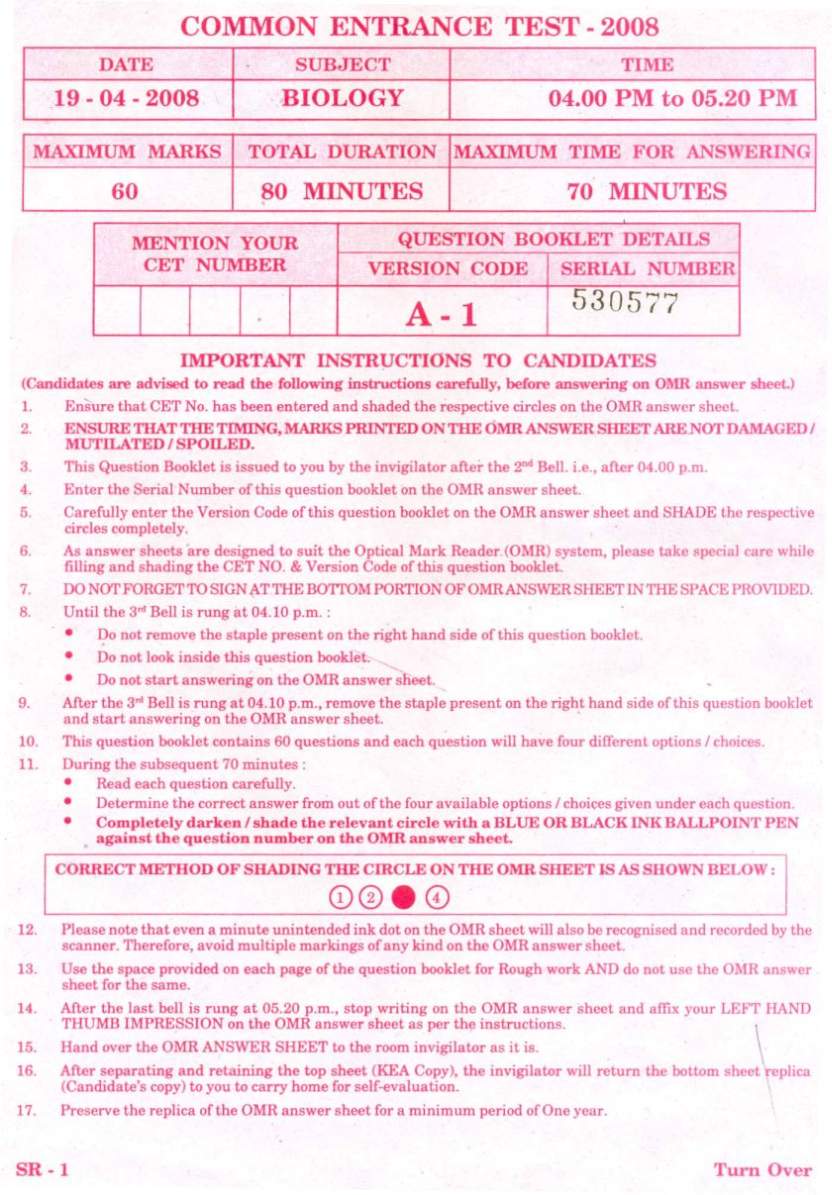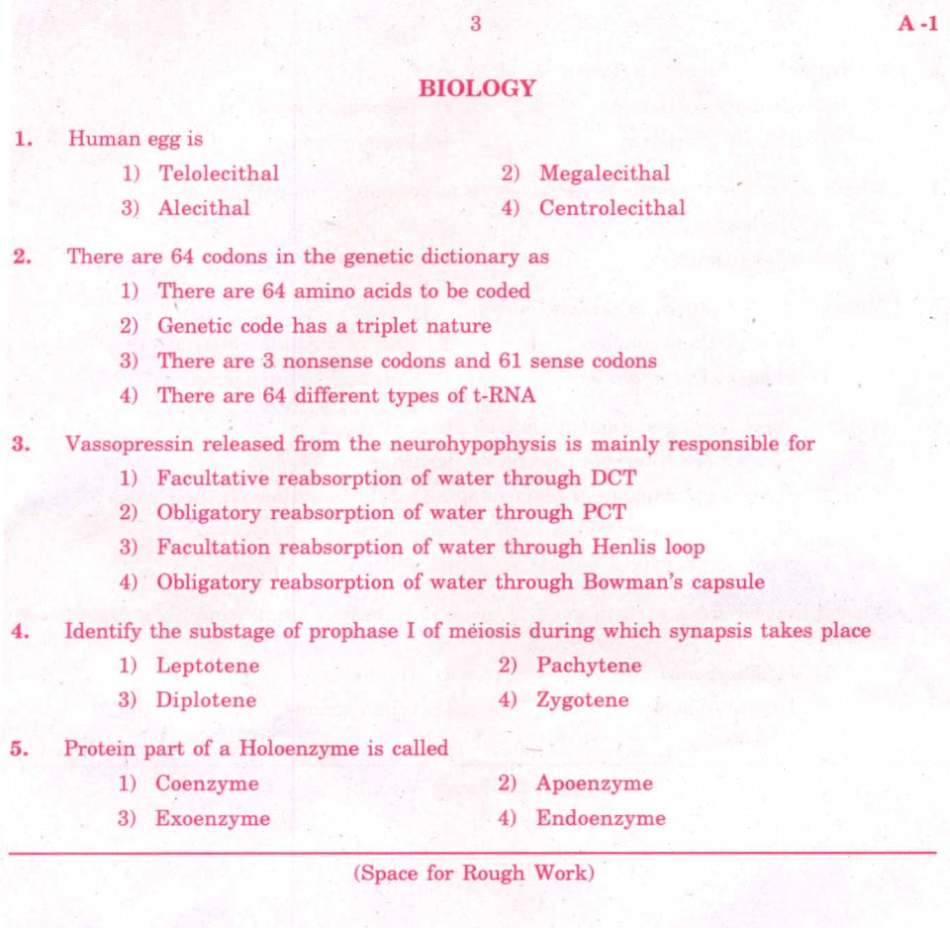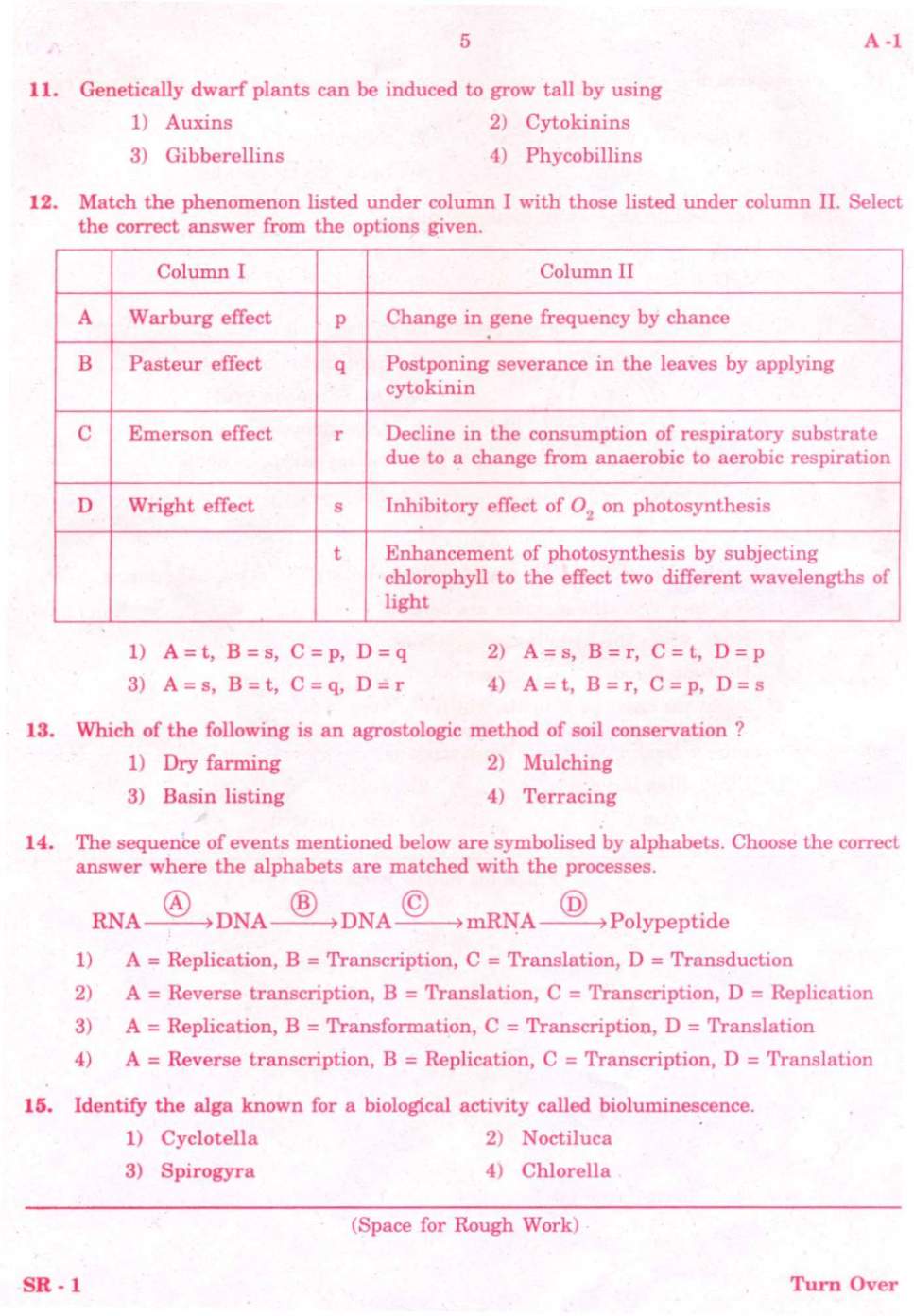|
#2
20th December 2014, 02:36 PM
| |||
| |||
| Re: Karnataka Diploma CET Model Paper
Karnataka Examinations Authority Diploma CET Biology Model Paper has questions from following topics: BOTANY CELL BIOLOGY AND GENETICS Chromosomes: Morphology, Structure and number (haploidy, diploidy. polyploidy and aneuploidy) Down's syndrome, Turner's syndrome and Klinefelter's syndrome. Ultrastructure of the chromosome Nucleosomes, (Nu bodies) Centromere, Kinetochore, Telomere, Euchromatin and heterochromatin; Salivary and lampbrush chromosomes. Nucleic Acids: Occurrence, chemical composition, duplex model of DNA. A brief account of DNA duplication; its importance as genetic material, RNA A brief account of structure and functions of rRNA, tRNA and mRNA, transcription of mRNA. Concept of gene - a brief account of gene structure - Lacoperon concept. Genetic Code and Protein Synthesis: Gregor Johann Mendel and His Work On Pea Plants: Laws of inheritance (Law of Segregation and Law of independent assortment) Monohybrid and dihybrid pattern of inheritance, Incomplete dominance (e.g. Mirabilis jalapa). Multiple allelism Descripiion of blood groups: A, B, AB and O, Mention of Rh factor and its significance - inheritance of blood groups. Sex Determination: Concept of autosomes and allosomes. Mechanism of sex determination by XX and XY methods in Drosophila and human beings (Genic balance theory not expected); Sex determination in plants (eg. Melandrium) Sex linked inheritance with respect to X-linked genes (eg. eye colour in Drosophila and coulur blindness and haemophilia in human beings). Inheritance of Y-linked genes (eg. hypertrichosis). Genetic Diseases: Phenylketonuria, sickle cell anaemia, Haemophilia and Albinism. Biotechnology: Concept of Biotechnology. Genetic engineering- plasmid as a vector (eg. PUC 18 or pbr 322) Gene cloning - insulin production: Genetic finger printing. Brief account of plant tissue culture. Improvement of crop plants (wheat and rice). General applications of biotechnology. HISTOLOGY AND PLANT ANATOMY Histology: Meristems, Parenchyma, Collenchyma, Sclerenchyma and Vascular tissues. Types of Vascular bundles. Plant Anatomy: Internal structures of dicot root (e.g. Helianthus), monocot root (eg. Maize), Dicot stem (eg. Helianthus), Monocot stem (eg. Maize), Dorsiventral leaf (eg. Helianthus) and Isobilateral leaf (eg. Maize). Secondary growth in dicot stem. [Note: All these internal structures can be studied in practical classes with the help of visual aids like charts] PLANT-WATER RELATIONS Significance of water for life, concept of imbibition, diffusion, osmosis, cohesion, osmotic potential, turgor pressure (pressure potential), water potential (water potentia = osmotic potential - pressure potential), Plasmolysis, deplasmolysis; Experiments to demonstrate osmosis - Potato osmoscope and Thistle funnel experiments [Experiments can be demonstrated in practical classes.] Absorption of Water: A brief account of the mechanism of water absorption and mineral absorption (carrier concept in brief). Ascent of Sap: Structure involved and a brief account of mechanism (pulsatory theory, Transpiration pull theory and Root pressure theory). Loss of Water: Transpiration and Guttation: Structures involved; structure of the stomatal apparatus, mechanism of stomatal movement (starch hydrolysis theory and proton concept). Experiments: Gonong's and Farmer's potometers with calculations. Translocation of Organic Solutes: Structure involved; Mechanism (Transcellular streaming and Mass flow hypothesis). BIOENERGETICS: Concept of Bioenergy and its involvement in plant growth and development. Photosynthesis: Ultrastructure of the chloroplast: Existence of photosystems; Definition of photosynthesis; Mechanism of photosynthesis light and Dark reactions (C3 pathway). Factors --- Law of limiting factors, Temperature, light, carbon dioxide and water Experiments: Light screen, Evolution of O2, Mohl's half leaf experiment and necessity of chlorophyll for photosynthesis. [ Note: Experiments can be studied in the practical classes.] Respiration: Ultrastructure of mitochondrion as a seat of respiration; Definition of respiration - Types of respiration, Respiration Quotient [RQ]. Mechanism of aerobic and anaerobic respirations; Pasteur's effect; A brief account of external and interna1 factors; Fermentation as in industrial process. Experiments: Evolution of CO2, Ganong's simple respiroscope. Thermos flask experiment and Kuhne's fermentation tube. Experiment to demonstrate anaerobic respiration. [Note: Experiments can be studied in the practical classes.J GROWTH: Definition, Regions of growth in the plant body, phases of growth, growth curve, measurement of growth rate by using Arc auxanometer with calculations. [Note: Expcriment can be studied in Practicals.] Factors: External factors (Light, temperature). Internal factors - plant hormones (Auxins, Gibberellins, Ethylene and ABA). Application of phytohormones in agriculture and horticulture INTRODUCTION TO ECOLOGY: Definition of Ecology, Autoecology, Synecology, Ecological units (species, population, community, ecosystem and Biosphere). Ecosystem: Classification, structural and functional components of an Ecosystem with pond ecosystem (Aquatic ecosystem) and Tropical deciduous forest (Terrestrial ecosytem) as examples. Energy flow in an ecosytem. Trophiclevels, food chain, food web, ecological pyramids (of number, biomass and energy), inverted pyramid of number in a parasitic food chain. Biogeochemical cycles (eg. carbon cycle, Nitrogen cycle, sulphur cycle and phosphorus cycles). Environmental Problems: Human population explosion and pollution (Air, water and soil pollulions), sources of pollution (Automobiles, industries, power plants, field burning, waste incinerations, pesticides, radioactive wastes and sewage); Effects of pollution and controlling measures. Development and Preservation of Ecosystems: Soil conservation methods. Afforestation, conservation of wild life (setting up of National parks, sanctuaries and zoos and legislation), Habitat preservation. ZOOLOGY MAN IN HEALTH & DISEASE HISTOLOGY Tissues: Basic types, location and functions, -Epithelium: (a) Simple: Squamous, Cuboidal, Columnar, Ci1iated and Glandular. (b) Compound: Stratified squamous. -Connective: Areolar, Adipose, Cartilage (hyaline, fibrous and elastic), Bone (mammalian). - Muscular: Striated, Non-striated and Cardiac. - Blood: Components - Nervous: Neuron (multipolar Myelinated neuron. - Histology of human small intestine to illustrate to organisation of tissues. DIGESTION - Structure of the different part of the human digestive system. - Process of digestion of carbohydrates, fats and proteins in the human alimentary canal. - A brief account of jaundice, hyperacidiity and ulcer. - Homeostasis - Definition, Meaning of internal environment. Example: Homeostatic functions of liver and pancreas in the regulation of blood sugar. Diabetes mellitus. CIRCULATION - Structure of human heart (V.S.), Mechanism of working of heart. - Types of Heart: Myogenic and Neurogenic - Definition with example. - Origin and conduction of heartbeat. Blood pressure, hepertension (arteriosclerosis) & hypotension. - Abnormalities in the heart: Heart enlargement (cardiomegaly) (a) Left ventricular hypertrophy due to aortic regurgitation, obesity and high blood pressure (b) Right ventricular hypertrophy (corpulmonale) due to hypertension in pulmonary circulation Defects in the valves - mitral stenosis and aortic stenosis. Septal holes - Atrial septal defect (ASD) and Ventricular Septal defect (VSD). Cyanosis (BlueBaby). Myocardial infarction. RESPIRATION - Structure of the human respiratory system. - Mechanism of respiration: Breathing, external respiration, (gaseous exchange at alveoli), internal respiration (transport of respiratory gases) and cellular respiration. - Disorders of respiratory system: Lung cancer, allergic disorders like hay fever (Rhinitis), asthama and bronchitis (Effects of smoking and pollutants are to be emphasized). EXCRETION - Gross structure of the nephron, formation of urine. - Disorder of the excretory system, renal failure and kidney stone formation, Significance of dialysis. NERVOUS SYSTEM - General organisation of human brain (sagittal section), functions of various topographical areas of cerebrum & structure of spinal cord (T.S.) - A brief study of the endocrine functions of pituitary - Disorders of the nervous system: Epilepsy, paralysis & haemorrhage causes and effects. - Effect of alcohol and narcotic drugs on the body. Efforts to counter the drug menace. CONTINUITY OF LIFE DEVELOPMENTAL BIOLOGY - General account of gametogenesis. - Strcture of generalised ovum and Sperm. - Types and mechanism of fertilization. - A brief account of early development upto the formation of primary germ layers in Frog (a typical vertebrate). - Listing the derivatives of germ layers. HUMAN REPRODUCTION - Structure of the sperm and Graafian follicle (to be studied in practicals.) - A brief note on fertilization implantation, placenta and role of sex hormones. - Need for birth control - a survey of family plnning methods. - Infertility control - Test tube babies (G.I.F.T.I.V.F. and E.T. techniques). - Sexually transmitted diseases - Gonorrhea, Syphilis and AIDS - causes and prevention. ORIGIN AND EVOLUTION OF LIFE OR IGIN OF LIFE - Concept of abiogenesis and biogenesis - Theory of chemical evolution of lice, Miller's experiment. ORGANIC EVOLUTION - A brief survey of Darwinism and Mutation Theory - Concept of Neo-Darwinism: - Hardy Weinberg law, source of Variations - 1. Sexual reproduction. 2. Genetic drift. 3. Mutation. 4. Isolation. ANIMAL RESOURCES AND HUMAN WELFARE DAIRY - Utility of cattle (livestock) in agriculture, transport and food. - Composition of milk - Important breeds of cattle like Hallikar and Nagapuri - Cross breeding with breeds like Red Dane, Jersey, Holstein and its advantages. - Superovulation and embryo transplantation - Importance of cattle in leather industry, biogas, fertilzers and gelatin. POULTRY - Importance of eggs in combating protein malnutrition. - Poultry as a subsidiary source of income. - Importance of high yielding varieties like white leg horn and Rhode island. - Table varieties like Plymouth rock, New hamphshire and breeds 1ike Giriraj. SERICULTURE - Introduction to sericulture as an agro industry. - Importance of mulberry cultivation. - Life cycle of silk moth. - Varieties of silk (mulberry and non- mulberry). - Byproducts of Silk industry. PISCICULTURE - Economics of fish farming - Inland fisheries. • - Food fishes of Karnataka: Labeo, catla Cirrhina, Rohu and Catfishes (only the names shall be mentioned.) Karnataka Diploma CET Question paper     For detailed paper, here is attachment...................... |